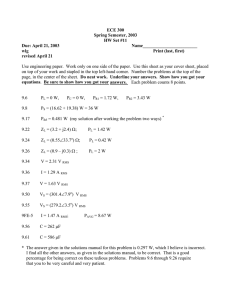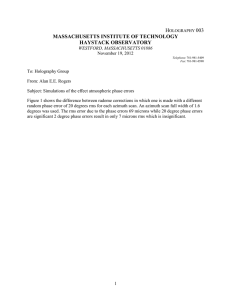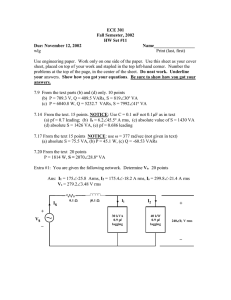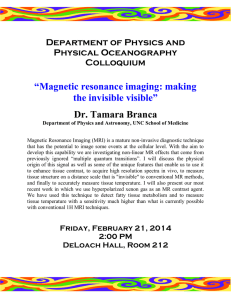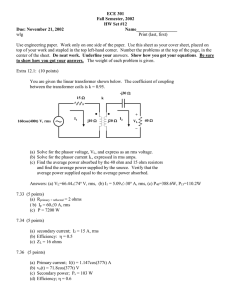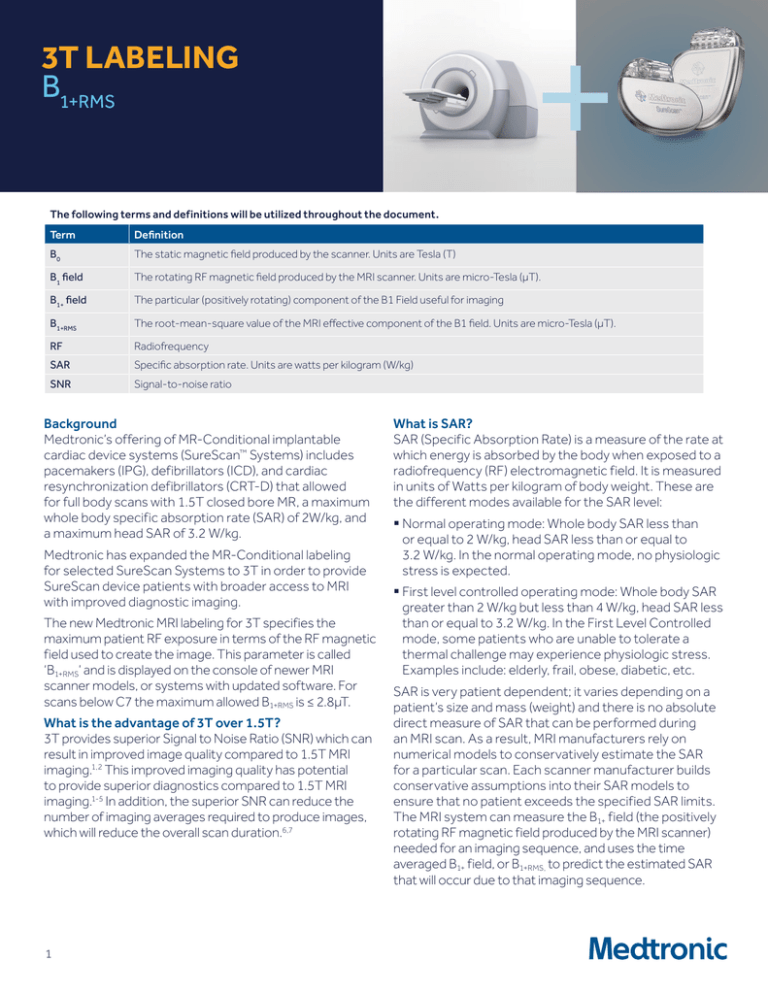
3T LABELING
B1+RMS
The following terms and definitions will be utilized throughout the document.
Term
Definition
B0
The static magnetic field produced by the scanner. Units are Tesla (T)
B1 field
The rotating RF magnetic field produced by the MRI scanner. Units are micro-Tesla (µT).
B1+ field
The particular (positively rotating) component of the B1 Field useful for imaging
B1+RMS
The root-mean-square value of the MRI effective component of the B1 field. Units are micro-Tesla (µT).
RF
Radiofrequency
SAR
Specific absorption rate. Units are watts per kilogram (W/kg)
SNR
Signal-to-noise ratio
Background
Medtronic’s offering of MR-Conditional implantable
cardiac device systems (SureScan™ Systems) includes
pacemakers (IPG), defibrillators (ICD), and cardiac
resynchronization defibrillators (CRT-D) that allowed
for full body scans with 1.5T closed bore MR, a maximum
whole body specific absorption rate (SAR) of 2W/kg, and
a maximum head SAR of 3.2 W/kg.
Medtronic has expanded the MR-Conditional labeling
for selected SureScan Systems to 3T in order to provide
SureScan device patients with broader access to MRI
with improved diagnostic imaging.
The new Medtronic MRI labeling for 3T specifies the
maximum patient RF exposure in terms of the RF magnetic
field used to create the image. This parameter is called
‘B1+RMS’ and is displayed on the console of newer MRI
scanner models, or systems with updated software. For
scans below C7 the maximum allowed B1+RMS is ≤ 2.8µT.
What is the advantage of 3T over 1.5T?
3T provides superior Signal to Noise Ratio (SNR) which can
result in improved image quality compared to 1.5T MRI
imaging.1,2 This improved imaging quality has potential
to provide superior diagnostics compared to 1.5T MRI
imaging.1-5 In addition, the superior SNR can reduce the
number of imaging averages required to produce images,
which will reduce the overall scan duration.6,7
1
What is SAR?
SAR (Specific Absorption Rate) is a measure of the rate at
which energy is absorbed by the body when exposed to a
radiofrequency (RF) electromagnetic field. It is measured
in units of Watts per kilogram of body weight. These are
the different modes available for the SAR level:
§ Normal operating mode: Whole body SAR less than
or equal to 2 W/kg, head SAR less than or equal to
3.2 W/kg. In the normal operating mode, no physiologic
stress is expected.
§ First level controlled operating mode: Whole body SAR
greater than 2 W/kg but less than 4 W/kg, head SAR less
than or equal to 3.2 W/kg. In the First Level Controlled
mode, some patients who are unable to tolerate a
thermal challenge may experience physiologic stress.
Examples include: elderly, frail, obese, diabetic, etc.
SAR is very patient dependent; it varies depending on a
patient’s size and mass (weight) and there is no absolute
direct measure of SAR that can be performed during
an MRI scan. As a result, MRI manufacturers rely on
numerical models to conservatively estimate the SAR
for a particular scan. Each scanner manufacturer builds
conservative assumptions into their SAR models to
ensure that no patient exceeds the specified SAR limits.
The MRI system can measure the B1+ field (the positively
rotating RF magnetic field produced by the MRI scanner)
needed for an imaging sequence, and uses the time
averaged B1+ field, or B1+RMS, to predict the estimated SAR
that will occur due to that imaging sequence.
What is B1+RMS?
B1+RMS is the time-averaged RF magnetic field component
relevant for creating an MR image that is generated by
the scanner during a scan and is measured in units of
micro-Tesla (µT). Understanding the importance of B1+RMS
to 3T MR-Conditional labeling requires a brief overview of
some basic MRI physics.
When a patient enters an MRI magnet, protons in the
body align in the direction of the B 0 magnetic field similar
to a compass aligning with the earth’s magnetic field.
An MR imaging sequence is composed of a series of
RF pulses that produce a magnetic field that interacts
with these magnetically aligned protons and rotates
them through a specific angle typically called the ‘flip
angle’ or ‘tip angle.’ The RF magnetic field produced
by the scanner is called the ‘B1’ field of which only one
part known as the positively rotating or ‘+’ component is
useful for ‘flipping’ the magnetically aligned protons and
allows images to be created. The maximum 10-second
time averaged B1+ field strength8 of the RF pulses in the
imaging sequence is the root-mean-square or ‘RMS’ B1+
value of the imaging sequence. Figure 1 defines each of
the elements of the symbol B1+RMS.
B1+RMS
The magnetic
field generated
by the RF coil
Root-mean-square
(maximum
10-second time
average RF pulses)
The particular (positively rotating)
component of the B1 field useful
for imaging
Figure 1: Definition of B1+RMS
What is the Advantage of using B1+RMS over SAR?
B1+RMS is a more precise RF exposure metric than SAR.
§ One reason for this is because B1+RMS is the time
averaged fundamental RF field parameter related to
MR image creation. The scanner calibrates the RF pulse
B1+ field strength during pre-scan and the B1+RMS value
for an imaging sequence is determined by the scan
parameters needed to produce the desired
tissue contrast.
2
§ Another reason that B1+RMS is a more precise RF
exposure metric than SAR is that it is patient
independent. In contrast, SAR is a conservative
estimate of the RF power deposited in a specific region
of the patient under examination (head, whole-body,
and partial-body) for a particular B1+RMS value. Predicting
SAR from the known B1+RMS value is a complicated
function of patient weight, morphology, tissue
composition, posture, landmark location and averaging
time. MRI scanners estimate the SAR for each scan
and account for patient specific attributes using realtime RF power supervision combined with proprietary
computational algorithms that have unknown safety
margins.
The B1+RMS limit of ≤ 2.8µT identified in Medtronic
SureScan Systems’ MRI labeling is independent of such
manufacturer specific approaches to SAR estimation
and represents the actual RF field exposure that is safe
for all patients implanted with Medtronic full-body eligible
SureScan System using any 3T scanner that meets the
requirements specified in the labeling.
Last but not least, imaging sequences that have been
configured for a certain B1+RMS can be saved for future use
and will be relatively consistent when recalled since B1+RMS
isn’t patient dependent. However, if an imaging sequence
was configured for a particular SAR value, when that
sequence is recalled the SAR can often vary by large
amounts depending on the patient.
“From my point of view, considering how troublesome
SAR is for RF safety “predictions,” the sooner we switch
our approach throughout the industry away from SAR and
to a more quantifiable and reproducible unit such as B1+RMS
— the better.”
Emanuel Kanal, MD, FACR, FISMRM, MRMD, AANG
Professor of Radiology and Neuroradiology
Director of Magnetic Resonance (MR) Service
University of Pittsburgh
“Setting parameters based on B1+RMS instead of SAR is a
significant advance for patients and clinicians because
B1+RMS is a more accurate and reproducible measure of
potential implant heating in the MRI scanner. Utilising
B1+RMS for implant labeling allows for the greatest possible
performance of MRI scanning protocols while also
ensuring patient safety.”
Yair Safriel, MBBCh, MD
Interventional & Diagnostic Spine and Neuroradiologist
Chief Medical Officer, Pharmascan Clinical Trials
Asst. Clin Professor, University of South Florida
If B1+RMS is a better measure of the RF field and SAR is
based on this measure, why did Medtronic use SAR for
their initial labeling?
Prior to 2010, manufacturers of MRI scanners weren’t
required to display the value for B1+RMS . Therefore, when
Medtronic’s initial SureScan MRI cardiac systems were
released in 2008, it was not practical to label these
devices to B1+RMS since the MR technologist would have
no means of verifying that they were conforming to
the labeling.
What is the maximum RF output allowed under the
3T labeling?
As of May 2016, selected Medtronic SureScan cardiac
systems are approved for a scan in a 3T scanner that
can display B1+RMS with the following requirements:
§ 3T closed bore clinical MRI used for hydrogen
proton imaging
§ Maximum spatial gradient of ≤ 20T/m (2,000 gauss/cm)
§ Maximum gradient slew rate performance per axis
≤ 200 T/m/s
§ No restriction if the isocenter is at or superior to the
C7 vertebra
§ B1+RMS must be ≤ 2.8µT when isocenter is inferior to the
C7 vertebra
Why did Medtronic choose B1+RMS labeling for 3T MRI?
Medtronic’s 3T labeling (which utilizes B1+RMS) allows for
the greatest access to 3T MRI, without compromised
performance. Medtronic arrived at the specified 3T
labeling using B1+RMS in order to allow the greatest possible
MR performance of 3T systems and reduce the impact
on radiology staff, while simultaneously ensuring patient
safety from implant heating.
Does this mean I need to change my scan sequences
to stay within this limit?
The 2.8µT B1+RMS limit is not expected to limit current
3T scan protocols for scans below C7, thus no
modification of scan sequences should be required.
In most scenarios, basic SAR restrictions that are applied
for all patients (associated with the limits imposed by
First Level Controlled Operating Mode9) will prevent scan
sequences from operating above 2.8µT when positioned
inferior to the C7 vertebra. Scan sequences superior
to the C7 vertebra have only First Level Controlled
Operating Mode limits. The general principles that an
MR technologist uses to reduce SAR can be used to
reduce B1+RMS .
If a scan sequence were to be encountered that is greater
than 2.8µT for a landmark position inferior to the C7
vertebra, the general principles used to create reduced
SAR protocols also apply to B1+RMS reduction.
Is the B1+RMS Display available on all 3T Scanners?
No. The regulations that govern MRI equipment require
that B1+RMS must be displayed on all new MRI scanners
beginning in 20109 allowing a grace period until 2013.
Some major manufacturers added this feature to
scanners sold prior to 2013 as part of regular software
upgrades. Medtronic estimates that more than 75%
of installed 3T MRI scanners display B1+RMS , and this
percentage will continue to grow in the coming years.
Should the 3T scanner console not display the value for
B1+RMS then the patient should not be scanned in said
scanner. Consider finding a different 3T scanner with
B1+RMS or scanning the patient at 1.5T instead. If you are
unsure whether a scanner displays B1+RMS , or is eligible for
a software upgrade that enables this feature, contact the
scanner manufacturer.
Where is B1+RMS Displayed on the Scanner Console?
The location of the B1+RMS display on the scanner console
is different for each manufacturer but is likely to be
displayed in close proximity to SAR.
3
References 1
Kamada K, Kakeda S, Ohnari N, Moriya J, Sato T, Korogi Y. Signal intensity of motor and sensory cortices on T2-weighted and FLAIR images:
intraindividual comparison of 1.5T and 3T MRI. Eur Radiol. December 2008;18(12):2949-2955.
2
Stankiewicz JM, Glanz BI, Healy BC, et al. Brain MRI lesion load at 1.5T and 3T versus clinical status in multiple sclerosis. J Neuroimaging.
April 2011;21(2):e50-e56.
3
Luccichenti G, Giugni E, Péran P, et al. 3 Tesla is twice as sensitive as 1.5 Tesla magnetic resonance imaging in the assessment of diffuse
axonal injury in traumatic brain injury patients. Funct Neurol. Apr-Jun 2010;25(2):109-114.
4
Craven I, Griffiths PD, Hoggard N. Magnetic resonance imaging of epilepsy at 3 Tesla. Clin Radiol. March 2011;66(3):278-286.
5
Alvarez-Linera J. 3T MRI: advances in brain imaging. Eur J Radiol. September 2008;67(3):415-426.
6
http://www.ncbi.nlm.nih.gov/pubmed/16555259Multicontrast black-blood MRI of carotid arteries: comparison between 1.5 and 3 tesla
magnetic field strengths.
7
http://www.biomedsearch.com/article/Cardiovascular-MRI-at-3T/209239236.html and http://www.medscape.com/viewarticle/566817
Cardiovascular MRI at 3T.
8
As specified in IEC 60601-2-33, “the maximum 10 second time averaged…”
9
IEC 60601-2-33 (Third edition – 2010).
Brief Statement See the MRI SureScan™ Technical Manual before performing an MRI Scan and Device Manual for detailed information regarding the implant
procedure, indications, contraindications, warnings, precautions, and potential complications/adverse events.
For further information, please call Medtronic at 1 (800) 328-2518 and/or consult Medtronic’s website at www.medtronic.com or
www.mrisurescan.com.
Caution: Federal law (USA) restricts this device to sale by or on the order of a physician.
Medtronic
710 Medtronic Parkway
Minneapolis, MN 55432-5604
USA
Tel: (763) 514-4000
Fax:(763) 514-4879
medtronic.com
Toll-free: 1 (800) 328-2518
(24-hour technical support for
physicians and medical professionals)
UC201607294 EN © Medtronic 2016.
Minneapolis, MN. All Rights Reserved.
Printed in USA. 04/2016

